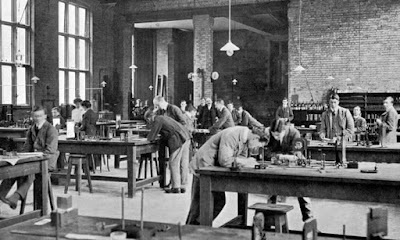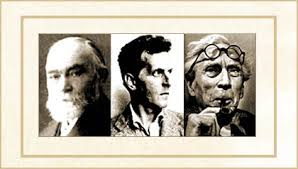A previous post noted the rapid transition in the twentieth century from small physics (Niels Bohr) to large physics (Ernest Lawrence). How should we understand the development of scientific knowledge in physics during this period of rapid growth and discovery?
One approach is through the familiar methods and narratives of the history of science -- what might be called "internal history of science". Researchers in the history of science generally approach the discipline from the point of view of discovery, intellectual debate, and the progress of scientific knowledge. David Cassidy's book Beyond Uncertainty: Heisenberg, Quantum Physics, and The Bomb is sharply focused on the scientific and intellectual debates in which Heisenberg was immersed during the development of quantum theory. His book is fundamentally a narrative of intellectual discovery. Cassidy also takes on the moral-political issue of serving a genocidal state as a scientist; but this discussion has little to do with the history of science that he offers. Peter Galison is a talented and imaginative historian of science, and he asks penetrating questions about how to explain the advent of important new scientific ideas. His treatment of Einstein's theory of relativity in Einstein's Clocks and Poincare's Maps: Empires of Time, for example, draws out the importance of the material technology of clocks and the intellectual influences that flowed through the social networks in which Einstein was engaged for Einstein's basic intuitions about space and time. But Galison too is primarily interested in telling a story about the origins of intellectual innovation.
It is of course valuable to have careful research studies of the development of science from the point of view of the intellectual context and concepts that influenced discovery. But fundamentally this approach leaves largely unexamined the difficult challenge: how do social, economic, and political institutions shape the direction of science?
The interdisciplinary field of science, technology, and society studies (STS) emerged in the 1970s as a sociological discipline that looked at laboratories, journals, and universities as social institutions, with their own interests, conflicts, and priorities. Hackett, Amsterdamska, Lynch, and Wajcman's Handbook of Science and Technology Studies provides a good exposure to the field. The editors explain that they consulted widely across researchers in the field, and instead of a unified and orderly "discipline" they found many cross-cutting connections and concerns.
What emerged instead is a multifaceted interest in the changing practices of knowledge production, concern with connections among science, technology, and various social institutions (the state, medicine, law, industry, and economics more generally), and urgent attention to issues of public participation, power, democracy, governance, and the evaluation of scientific knowledge, technology, and expertise. (kl 98)The guiding idea of STS is that science is a socially situated human activity, embedded within sets of social and political relations and driven by a variety of actors with diverse interests and purposes. Rather than imagining that scientific knowledge is the pristine product of an impersonal and objective "scientific method" pursued by selfless individuals motivated solely by the search for truth, the STS field works on the premise that the institutions and actors within the modern scientific and technological system are unavoidably influenced by non-scientific interests. These include commercial interests (corporate-funded research in the pharmaceutical industry), political interests (funding agencies that embody the political agendas of the governing party), military interests (research on fields of knowledge and technological development that may have military applications), and even ideological interests (Lysenko's genetics and Soviet ideology). All of these different kinds of influence are evident in Hiltzik's account in Big Science: Ernest Lawrence and the Invention that Launched the Military-Industrial Complex of the evolution of the Berkeley Rad Lab, described in the earlier post.
In particular, individual scientists must find ways of fitting their talents, imagination, and insight into the institutions through which scientific research proceeds: universities, research laboratories, publication outlets, and sources of funding. And Hiltzik's book makes it very clear that a laboratory like the Radiation Lab that Lawrence created at the University of California-Berkeley must be crafted and designed in a way that allows it to secure the funds, equipment, and staff that it needs to carry forward the process of fundamental research, discovery, and experimentation that the researchers and the field of high-energy physics wished to conduct.
STS scholars sometimes sum up these complex social processes of institutions, organizations, interests, and powers leading to scientific and technological discovery as the "social construction of technology" (SCOT). And, indeed, both the course of physics and the development of the technologies associated with advanced physics research were socially constructed -- or guided, or influenced -- throughout this extended period of rapid advancement of knowledge. The investments that went into the Rad Lab did not go into other areas of potential research in physics or chemistry or biology; and of course this means that there were discoveries and advances that were delayed or denied as a result. (Here is a recent post on the topic of social influences on the development of technology; link.)
The question of how decisions are made about major investments in scientific research programs (including laboratories, training, and cultivation of new generations of science) is a critically important one. In an idealized way one would hope for a process in which major multi-billion dollar and multi-decade investments in specific research programs would be made in a rational way, incorporating the best judgments and advice of experts in the relevant fields of science. One of the institutional mechanisms through which national science policy is evaluated and set is the activity of the National Academy of Science, Engineering, and Medicine (NASEM) and similar expert bodies (link). In physics the committees of the American Physical Society are actively engaged in assessing the present and future needs of the fundamental science of the discipline (link). And the National Science Foundation and National Institutes of Health have well-defined protocols for peer assessment of research proposals. So we might say that science investment and policy in the US have a reasonable level of expert governance. (Here is an interesting status report on declining support for young scientists in the life sciences in the 1990s from an expert committee commissioned by NASEM (link). This study illustrates the efforts made by learned societies to assess the progress of research and to recommend policies that will be needed for future scientific progress.)
But what if the institutions through which these decisions are made are decidedly non-expert and bureaucratized -- Congress or the Department of Energy, for example, in the case of high-energy physics? What if the considerations that influence decisions about future investments are importantly directed by political or economic interests (say, the economic impact of future expansion of the Fermilab on the Chicago region)? What if companies that provide the technologies underlying super-conductor electromagnets needed for one strategy but not another are able to influence the decision in their favor? What are the implications for the future development of physics and other areas of science of these forms of non-scientific influence? (The decades-long case of the development of the V-22 Osprey aircraft is a case in point, where pressures on members of Congress from corporations in their districts led to the continuation of the costly project long after the service branches concluded it no longer served the needs of the services; link.)
Research within the STS field often addresses these kinds of issues. But so do researchers in organizational studies who would perhaps not identify themselves as part of the STS field. There is a robust tradition within sociology itself on the sociology of science. Robert Merton was a primary contributor with his book The Sociology of Science: Theoretical and Empirical Investigations (link). In organizational sociology Jason Owen-Smith's recent book Research Universities and the Public Good: Discovery for an Uncertain Future provides an insightful analysis of how research universities function as environments for scientific and technological research (link). And many other areas of research within contemporary organizational studies are relevant as well to the study of science as a socially constituted process. A good example of recent approaches in this field is Richard Scott and Gerald Davis, Organizations and Organizing: Rational, Natural and Open Systems Perspectives.
The big news for big science this week is the decision by CERN's governing body to take the first steps towards establishment of the successor to the Large Hadron Collider, at an anticipated cost of 21 billion euros (link). The new device would be an electron-positron collider, with a plan to replace it later in the century with a proton-proton collider. Perhaps naively, I am predisposed to think that CERN's decision-making and priority-setting processes are more fully guided by scientific consensus than is the Department of Energy's decision-making process. However, it would be very helpful to have in-depth analysis of the workings of CERN, given the key role that it plays in the development of high-energy physics today. Here is an article in Nature reporting efforts by social-science observers like Arpita Roy, Knorr Cetina, and John Krige to arrive at a more nuanced understanding of the decision-making processes at work within CERN (link).














